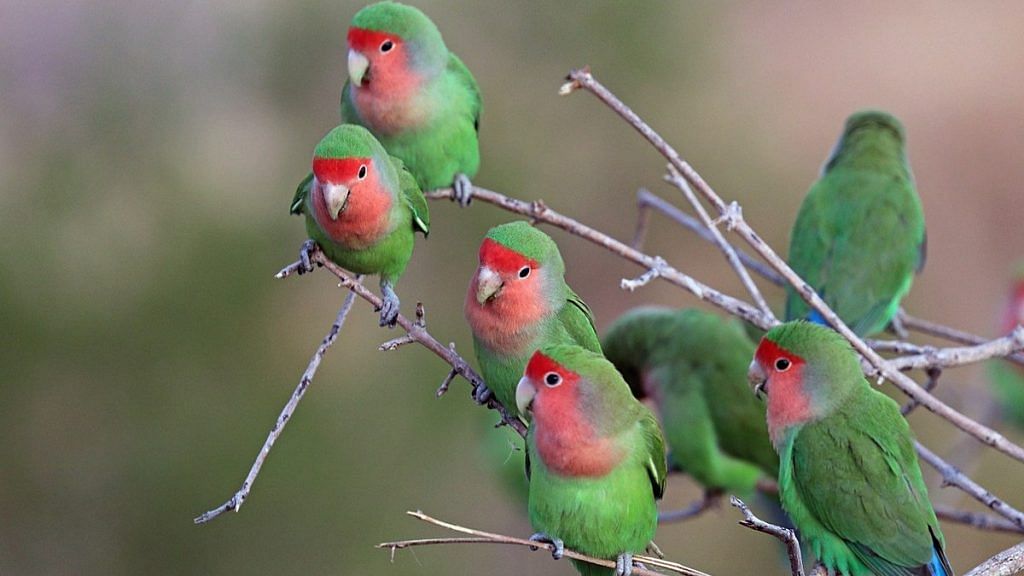Bengaluru: There is no bird, mammal, reptile or fish, living or extinct, on planet Earth that is known to have an odd number of limbs. But parrots are defying this “forbidden” phenotype or physical trait by using their beaks as a third limb to propel their bodies while climbing, a study has said.
A group of researchers from the New York Institute of Technology arrived at the conclusion after studying the movements of six young adult rosy-faced lovebirds (scientific name Agapornis roseicollis) — small, pink-faced birds native to southwestern Africa and belonging to the parrot family.
What is significant about the authors’ findings is that this is the first observation of tripedalism (locomotion by use of three limbs) in birds, or in any vertebrates.
The findings, which have been peer-reviewed, were published Wednesday in the Proceedings of the Royal Society B, the flagship biological research journal of the Royal Society, the United Kingdom’s national academy of sciences.
Parrots belong to the Psittaciformes family, which includes parakeets, cockatiels, budgies, keas, macaws, lorikeets, and other birds that have curved beaks and strong legs. They also have two toes pointing forward and two backward, and walk by alternating their legs instead of hopping on both feet.
According to the authors, being unable to use their wings as grasping forelimbs, parrots have evolved to become resourceful climbers by co-opting their feeding system — the head, beak, mouth, and neck — to act as an additional ‘limb’.
Also Read: Peace on Pakistan border boosts J&K’s Gharana Wetland, 15 new migratory bird species show up
How the study was conducted
According to the authors, parrots have anecdotally been reported to use their beak for movement. Those kept as pets have been seen using their beaks to climb surfaces or swinging from ropes and branches. However, this behaviour had so far not been documented in scientific literature and is considered a “forbidden phenotype” or physical trait, the study says.
The researchers set out to determine whether parrots use their beaks simply as a hook or anchor (‘effective limb’) to stabilise themselves when climbing, or whether they use it as an extra limb (‘propulsive limb’) to actually carry their body weight and propel it upwards.
For the study, the authors purchased six rosy-faced lovebirds from a pet shop and observed them climbing and walking on a surface they had constructed. The plank was capable of rotating and inclining at angles up to 90°. It was fitted with sensors that determined the force applied on it, and high-speed cameras were set up to capture bird movement.
The researchers observed how the beak, limbs, and tail were used when walking and climbing.
They noticed that, when walking on a flat surface, the birds did not touch their beak or tail to the ground. They continued to comfortably walk on two feet until the plank was inclined to an angle of 45°.
As the birds moved along the 45° inclined plane, the tail started to remain in constant contact with the plank surface, and the birds started using their beaks for assistance. When the surface was fully vertical, the birds used their beaks consistently to climb.
Data from the surface of the plank indicated that while the tail did not exert any force, the beak exerted enough force to push the body of the lovebird forward.
The strength required to perform this motion indicates that parrots have appropriated their feeding apparatus and neck flexors to aid in movement, the authors say in their findings, adding that further study is required to determine how frequently the beak is used during locomotion in parrots, and how and why this behaviour has evolved in parrots and not other birds.
Pentapedal movement in kangaroos & spider monkeys
While no vertebrate is known to naturally have an odd number of limbs, some animals have adopted gaits that involve using a part of their body as an extra limb.
For example, kangaroos use their tails as a “very capable leg” when moving pentapedally (using five legs, in this case, four legs and a tail), according to a 2014 study. Their tail is powerful enough to assist with both resting and slow hopping, enabling the kangaroo to propel itself off its hind legs.
Similar behaviour has been observed in spider monkeys, who use their prehensile (able to hold things) tail to hang fully from tree branches.
(Edited by Gitanjali Das)
Also Read: With aim to avoid bird deaths, wildlife board to draft norms for power lines in protected areas
